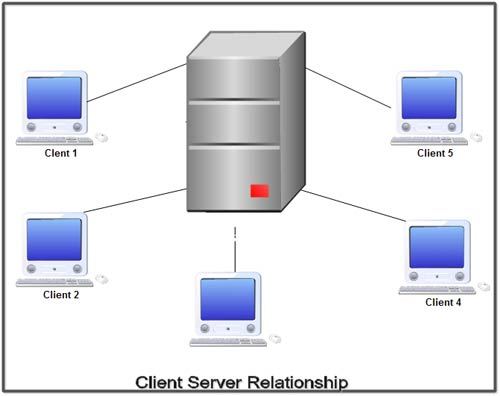• A Computer networking model where one or more powerful computers (servers) provide the different computer network services and all other user’of computer network (clients) access those services to perform user’s tasks is known as client/server computer networking model.
• In such networks, there exists a central controller called server. A server is a specialized computer that controls the network resources and provides services to other computers in the network.
• All other computers in the network are called clients. A client computer receives the requested services from a server.
• A server performs all the major operations like security and network management.
• All the clients communicate with each other via centralized server
• If client 1 wants to send data to client 2, it first sends request to server to seek permission for it. The server then sends a signal to client 1 allowing it to initiate the communication.
• A server is also responsible for managing all the network resources such as files, directories, applications & shared devices like printer etc.
• If any of the clients wants to access these services, it first seeks permission from the server by sending a request.
• Most Local Area Networks are based on client server relationship.
Client-server networking became popular in the late 1980s and early 1990s as many applications were migrated from centralized minicomputers and mainframes to computer networks of persona computers.

The design of applications for a distributed computing environment required that they effetely be divided into two parts: client (front end) and server (back end). The network model on which they were implemented mirrored this client-server model with a user’s PC (the client) typically acting as the requesting machine and a more powerful server machine to which it was connected via either a LAN or a WAN acting as the supplying machine. It requires special networking operating system. It provides user level security and it is more expensive.
We’ll be covering the following topics in this tutorial:
Advantages of Client Server Networks
1. Centralized back up is possible.
2. Use of dedicated server improves the performance of whole system.
3. Security is better in these networks as all the shared resources are centrally administered.
4. Use of dedicated servers also increases the speed of sharing resources.
Disadvantages of Client Server Networks
1. It requires specialized servers with large memory and secondary storage. This leads to increase in the cost.
2. The cost of network operating system that manages the various clients is also high.
3. It requires dedicated network administrator.
 Dinesh Thakur holds an B.C.A, MCDBA, MCSD certifications. Dinesh authors the hugely popular
Dinesh Thakur holds an B.C.A, MCDBA, MCSD certifications. Dinesh authors the hugely popular